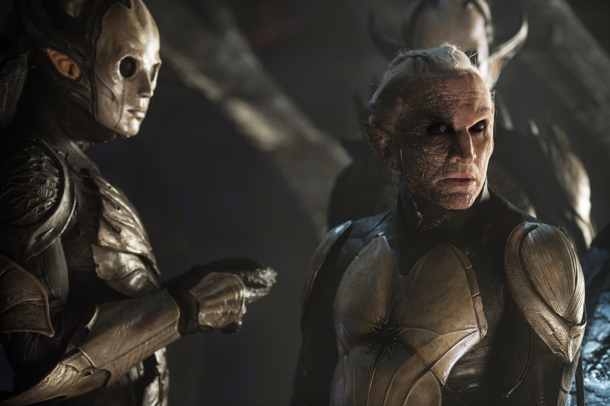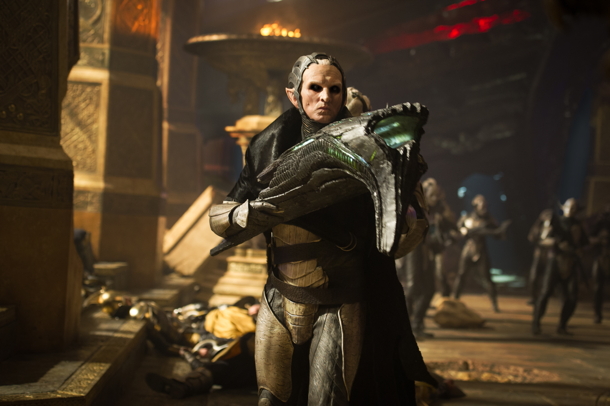Christopher Eccleston Talks Thor: The Dark World
From Ninth Doctor to the Nine Realms in Thor: The Dark World

Were you familiar with the Thor comic book prior to signing on to the movie?
In my childhood, around about the late ’60s, early ’70s, my eye was caught by Marvel’s comic book Thor . The Marvel comics tended to concentrate on Americana and obviously with Thor they were departing into European mythology. It was different.
What attracted you to Thor: The Dark World ?
Alan Taylor [the director] was key in that. Playing a villain in a project like this can be risky because often these films feel that they require one-dimensional, unmotivated evil. But in the audition when talking to Alan it was, “How do we make him more interesting than just a cackling fiend?” And it was Alan’s sensibility and the way we spoke together about the project that made me feel we could perhaps give Malekith some complexity, because that’s what the audiences demand. They have that of the heroes, and the villains need that as well.
Did you feel a sense of pressure knowing how established the Marvel Cinematic Universe already is?
No, the only pressure I feel is the pressure I put on myself as an actor. I don’t dwell on that kind of thing; it’s just not useful. I put huge amounts of pressure on myself in terms of what I want to achieve.
Did you see the first Thor film?
I did see the first film and I enjoyed it very much, particularly the performances. For Chris Hemsworth it’s a big ask to be this extraordinary comic book physical specimen, which he can do. But what I loved about his performance – and a lot of the performances, but particularly Chris’s –was the humour and the twinkle and the charm and the sense that he was taking it seriously but not that seriously. That’s been the proof of working with him on this, really. I admire that. He’s not just a comic book hero, he’s a Norse hero, and he’s got the long flowing locks and he’s muscular. To play that really takes some guts and some deftness of touch, and he has that. He’s the leader, really; he set the benchmark for us all.
This is the first time Malekith has been portrayed onscreen. Did you do much research prior to filming? I didn’t do a huge amount of research. I never do, actually, because I always think that the beauty of it is what your imagination does in conjunction with the script and the people that you’re collaborating with, particularly the director. Alan’s got very strong views of Malekith and has worked very hard to bring up antagonists that are worthy of Thor.
I looked at Google Images and there was the most famous image of Malekith, which is the one with the split face, black and white, burnt face, which we actually address. The icon of Malekith is the black and white face and the long, flowing locks, and that happens in the film. We create that look.
Weekly digests, tales from the communities you love, and more
How was the process of getting into the prosthetics?
It’s six hours in makeup for me, which I wasn’t aware of coming in. I’m on set very early to have makeup applied, if we’re in the first shot at seven. It also takes a lot of maintenance during the day. So for me, I’m doing 16-hour days at least. My costume’s very elaborate as well and high maintenance, so when I’m not on camera doing a take, I’ve got at least four people in my face around my body the whole time, so that takes a kind of discipline.
It’s a very elaborate costume made with great care, and the make-up as well. It’s pretty extraordinary. I wear contact lenses and I have prosthetics on my face. I have a different shaped head; I wear a wig and a cage on top of the wig. I also have body armour and a cloak, so it’s elaborate and transforming. The idea with prosthetics is that you still get a sense of a living creature, a living entity, and I think we’ve achieved that.


Why do you think it’s important to maintain the humorous beats throughout the film?
I wanted Malekith to have a sense of humour because I think a sense of humour indicates intelligence, and if you’ve got an intelligent villain that means that your heroes have to be really accomplished to beat them. It’s easy to beat a stupid villain; it’s pretty easy to outfox one.
In these kinds of films, it’s important not to take yourself too seriously. The audiences are there to have a good time and if there’s a slight knowing wink about the frivolity of the whole thing that’s usually useful. But that’s true of life. All the greatest literature has humor. Shakespeare, for example. You go and see a Shakespeare play like Richard III , which is a great play about a villain, but there were huge amounts of humour in it. Audiences need that. Then they’ll buy the heavy stuff and the special effects.
Can you talk a bit about the Elves’ language?
It was Alan’s innovation. He worked on Game Of Thrones and they’d used an invented language there. He was very keen for us to develop a language for the elves because at the beginning of this film you’re presenting an alternative race, and if the alternative race sounds like two English guys, who happen to be in prosthetics, it makes it hard to suspend your disbelief. So when you first meet us, we have our own language and that is a complete invention. It’s definitely based on European languages, and I think there’s probably some Finnish in there. It does have its logic and its rhythms. It also has many syllables and it’s very difficult to do while remaining naturalistic. It’s been a particular challenge, but hopefully it gives the film some complexity and variety.
What has it been like to work on practical sets so big?
When you see large sets like these, you realise that your performance has got to dominate that scale, otherwise you’re going to get lost in the set. You can look at a set or you can look at a costume or you can look at make-up, and that can inform how you play the character in terms of scale and commitment. You’ll find with any actor that they’ll look at a set and they’ll appreciate it, but really they’re concerned with their performance and how they can use those things around them to inform their performance and not get lost. It needs high-definition performing to leap out of some of these sets.
The movie has a cast of esteemed names. How did you find working with them?
Great, because I got to do scenes with all of them, and they’re all very different. It’s been a pleasure to work with Chris [Hemsworth]; he’s the man, and he welcomes everybody in and he sets the tone. He’s a lovely guy.
A big thrill was Tony Hopkins because when I was 19, I used to work at the National Theatre in London. I used to sell ice creams and tear tickets. While I was doing that Anthony Hopkins was playing Lambert Le Roux in a play called Pravda and King Lear and Antony in Antony And Cleopatra . I used to sit on a little seat right at the top of the theatre and watch him. I must have seen Anthony Hopkins on stage doing the same performance 200 times, and I never dreamed that I would play a scene with him. It was very strange for me to see this great actor, to study his work and then to play a scene with him. Sadly, the scene did not make the final cut but it was a huge thrill and honour for me, and completion of a circle really, because I learned a huge amount from those days just watching him on stage.
I don’t have a huge amount to do with Natalie Portman. I just snarl at her, which is a pleasant thing to do – she didn’t snarl back. I have a great fight with Rene Russo; we have a great hand-to-hand combat and we had a great time working together.
I’m aware of Tom Hiddleston because he’s a British actor and I’ve seen his star rise. He was very welcoming because obviously he’s a part of an established team here. It’s been great.
Thor: The Dark World is released on 2D Blu-ray, 3D Blu-ray, digital download and on demand on Monday 24 February.
SFX Magazine is the world's number one sci-fi, fantasy, and horror magazine published by Future PLC. Established in 1995, SFX Magazine prides itself on writing for its fans, welcoming geeks, collectors, and aficionados into its readership for over 25 years. Covering films, TV shows, books, comics, games, merch, and more, SFX Magazine is published every month. If you love it, chances are we do too and you'll find it in SFX.


